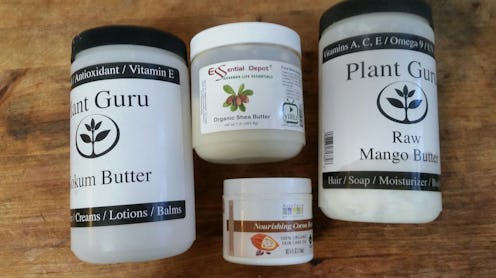
With all the butters in the world, it’s hard to know which one to cook with let alone which type of butter you should use on your hair and skin. That’s why a Butter 101 article is long overdue: Your butter of choice will depend on your skin and hair type and, of course, the things the beauty woes that ail you most.
Let’s talk about butter source first. To get the most out of your butter it’s essential to purchase a raw, organic product free of GMOs and other ingredients. Also, you should know that if you are relying on plant-based ingredients for anything from acne to dry skin or brittle hair, you will not see the same results as you will by using OTC products. This isn’t because OTC products necessarily work better; it’s mainly because the healing properties of plant-based products are more potent in their natural forms. When plant based oils are heated at high temperatures, many of the nutrients (certainly not all!) disappear. This is why you may see coconut oil for high heat cooking will be refined and coconut oil for beauty products will be unrefined.
While I like to consider myself a butter connoisseur, making some myself or just heavily researching the ones that are impossible to make, I still wanted to do some digging to break down the difference of seven of the most popular butters in beauty right now. I wasn’t at all surprised to learn that any of these butters can be used from head to toe, but the real gift from nature is that no matter who you are? There is a butter out there for you.
1. Kokum Butter
Kokum butter is one of my fave butters to use in my homemade lotion; it’s a natural emollient that is easily absorbed into the skin. Kokum has antibacterial, anti-inflammatory, and antioxidant properties making it an ideal moisturizer for oily or acne prone skin. You can take these kokum butter benefits from your skin and apply them on your scalp too!
2. Mango Butter
Mango butter is super nourishing. As a natural emollient, it’s similar to kokum butter, but stands out because of the many claims that it protects against UV rays. According to Aura Cacia Educator and Aromatherapist, Charlynn Avery, it’s a better idea to rely on butters in your sun aftercare than to rely on them solely to protect you from the sun. Mango butter is rich in vitamins A, C, and E and it’s a real treat after you’ve been soaking up the sun.
3. Olive Butter
Although olive butter is often sold in cosmetics as its own deal, most often the olive oil itself is infused with shea butter or coconut oil to give it a creamy texture. Olive butter is incredibly moisturizing and while it feels heavy during application, it’s quickly absorbed into the skin. My dry hands have been drinking up homemade olive butter on the reg lately.
4. Hemp Seed Butter
If you hadn’t guessed it, hemp seed butter comes from the cannabis plant sans THC, so while your skin may feel good enough to be high, it won’t be. You can attribute that glowing feeling to the easily absorbed butter hemp seed produces. According to sources at Blackhair101, hemp seed butter is rich in omeg-6 and amino fatty acids. Since hemp seed butter fights moisture loss you can use it from head to toe.
5. Shea Butter
Shea butter has proven time over time to be one of the best natural emollients, but that’s likely because it has the most research. According to Wellness Mama, a 2010 study classified shea butter as an anti-inflammatory. Rich in fatty acids, the butter from the shea nut increases collagen production, strengthens and improves skin elasticity. This is going to be a go-to butter for removing scars, cellulite, and diminishing the appearance of stretch marks, if you so desire.
6. Almond Butter
Almond butter, when made at home, is a natural exfoliate that’s high in vitamin E and omega 6 fatty acids. According to sources at Naturally Nutty, almond butter can prevent premature aging from UV rays and serves as a sufficient anti-inflammatory. Sounds like a perfect mask for a blemish-free face.
7. Cocoa Butter
Take one whiff of raw cocoa butter and you just know there are good things in store for your body and hair. Rich in antioxidants, cocoa butter creates a natural barrier between your body’s natural oils and the rest of the world that tries to break it down by protecting your skin. Cocoa butter reduces inflammation and can moisturize from your scalp all the way down to your feet. According to Charlynn, cocoa butter has been historically used to reduce the appearance of stretch marks. I, for one, have never made a homemade lotion without it.
You can use butters solo to get all the delicious moisturizing qualities, but combining your butters with oils and essentials can make for the lotion your bod has been dreaming of. Charlynn suggests adding a lighter oil when you melt your butter, particularly an oil that works best for your skin. “If you add a quick absorbing oil like apricot kernel or grapeseed, you can create a simple lotion that absorbs well and has a less heavy feel on the skin.”
Now that you’ve had your crash course, why not whip up a soothing lotion in your own kitchen?